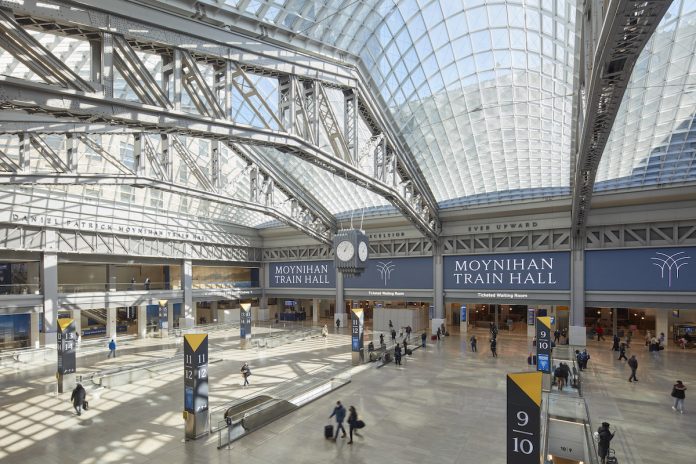How Moynihan Train Hall breathes new life into Penn Station
Penn Station, long removed from its glory days in the first half of the 20th century, had become notorious for all the wrong reasons. A controversial demolition in 1963 stripped the building of its grandeur and beauty. Gone was the grand concourse designed in the Beaux-Arts style with its illuminous, high-arched windows. In its place sat a windowless, featureless hub, denounced by critics as a failure of form and function. But in the 1990s, a voice from the station’s past would lead the charge to breathe new life into the forgotten landmark.
As a young boy growing up in New York City, Daniel Patrick Moynihan shined shoes at Penn Station. As an adult, he was a U.S. Senator representing the state of New York, and had begun to rally support for long overdue improvements to his former workplace. The plan? Build a new train hall inside the James A. Farley Building, a New York City designated landmark and National Historic Site. Designed by the famed architectural firm of McKim, Mead & White, creators of the original Penn Station, the building served for decades as the city’s general post office.
Erecting a new train hall inside the protected landmark created an enormous set of challenges, even by New York standards:
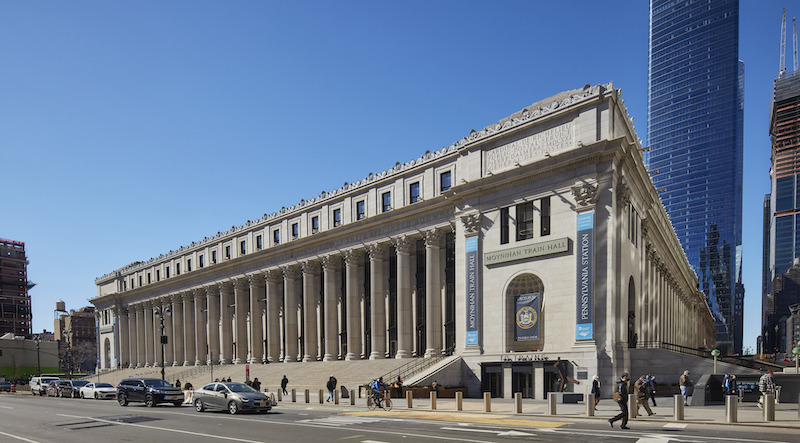
- Future meets past – The train hall had to preserve the historical design and structure of its surroundings, while at the same time bringing modern convenience and functionality to travelers.
- The City never sleeps – Shutting down Penn Station was never an option. Construction would have to take place while causing minimal disruption to the more than 700,000 daily passengers passing through the station.
- The world is watching – City, state, and federal dollars would all be utilized in the completion of this project. Politicians and citizens alike would be monitoring every step of the project, putting an immense amount of pressure on the teams involved to get the job done right.
- Welcome to the Concrete Jungle – New York commuters are not known for being a gentle bunch. The finished project would need to be a testament to durability and longevity, standing up to the toughest of environments.
- In a New York Minute – The project timeline was a tight one, and not even a global pandemic would stop progress on the train hall. The products used would need to help accelerate the project if the deadlines were to be met.
The architects at Skidmore, Owings & Merrill set forth a plan to make Moynihan Train Hall a welcoming and inviting presence for commuters. A 92-foot tall glass atrium would allow natural light to pour into the station. Expanded waiting areas and additional escalators would help ease crowding. And upgraded retail space would provide new shopping and dining options.
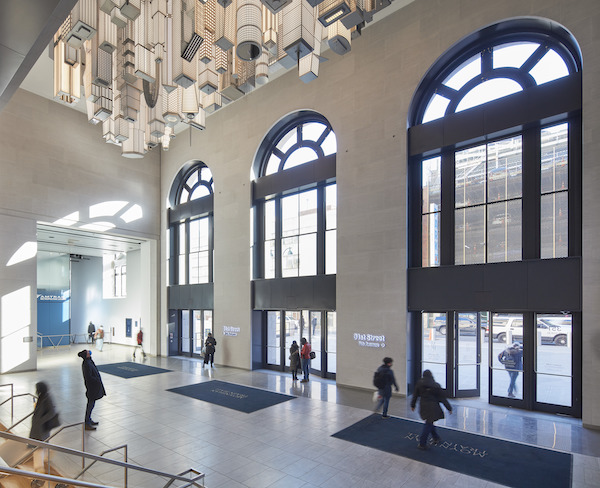

The lead contractor Skanska USA gave the job of installing the stone finishes to Miller Druck Specialty Contracting. A family-owned, third-generation business, they built a reputation for managing and completing complex stone installations throughout New York City and around the globe. Skidmore, Owings & Merrill, as well as consulting architect Rich Goldberg AIA, president of PROCON Consulting Architects would help design the complex floor assembly and specify the materials that would be used for this massive undertaking. A proven installation system that could be adapted to both historical areas of the building, and flow seamlessly into the new areas would be needed. The solution would be found in another family-owned, third-generation business – LATICRETE.
Overall construction kicked off in 2017. A massive hydronic heating and cooling system was installed to help control the climate of the train hall, and encased in concrete. Workers began preparing the substrate for the large marble slabs that would eventually adorn the floor of the train hall. Due to the unique circumstances and nature of this challenging project, with the help of New York’s largest and oldest tile distributors, Nemo Tile + Stone, the following installation processes were utilized:
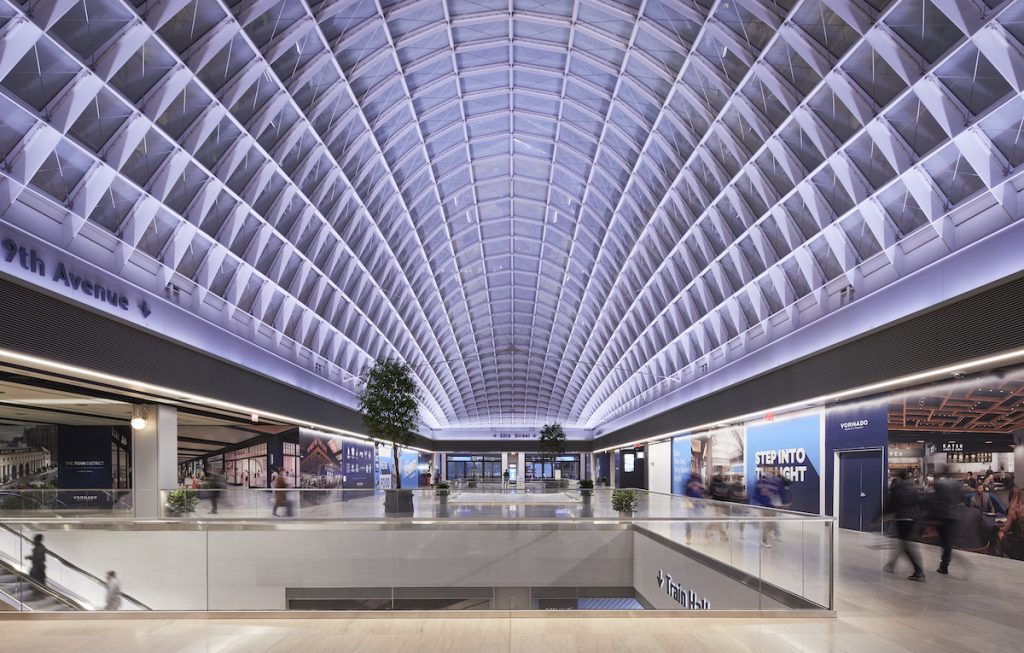

- In older areas with pre-existing damage to the substrate, LATICRETE® Blue 92 Anti-Fracture Membrane was applied to help prevent existing cracks and damage from telegraphing through to the new floor.
- In areas where new substrates were constructed, LATICRETE HYDRO BAN® waterproofing and crack-isolation membrane was applied to help prevent water and cracks from infiltrating the freshly-poured concrete slabs, minimizing damage for years to come. From there, a bonded layer of LATICRETE 3701 Fortified Mortar Bed was screened out, creating a flat, stable surface for the finished floor, ensuring strong, even adhesion and preventing the marble slabs from popping or breaking from the stress of the immense foot traffic in the station.
- Once the prep was completed, over 6,000 Tennessee Quaker stone floor tiles were installed on top of the mortar bed with LATICRETE 254 PLATINUMTM thin-set adhesive mortar. For areas around walls and escalators, LATAPOXY® 310 Stone Adhesive was used to install the large format stone slabs. Both products provide the ultimate adhesion and have passed the highest certifications for strength and durability, a must in a New York City train station.
- Stone and tile wall finishes in other areas of the project were applied with MULTIMAX® Lite, which would be able to support the large, heavy tiles without concerns of pieces falling off over time.
- For the finishing touches, color-coordinated PERMACOLOR® Grout was used to create long-lasting joints.
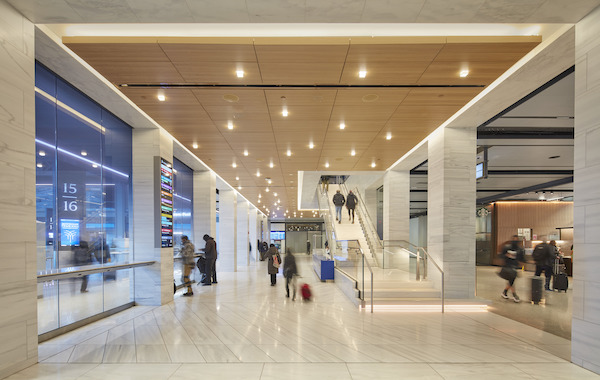

Beyond durability, these products offered a number of other benefits on the project. Many of the products selected come equipped with Microban® Antimicrobial Technology, helping to keep the train hall looking newer longer, while being easier to clean and preventing the growth of stain- and odor-causing bacteria. All the products used carry GREENGUARD certifications, meeting strict guidelines for low VOC emissions, creating healthier indoor air quality.
As with any project, challenges and surprises lie in wait around every corner, especially in a century-old building. The executive and technical services teams at LATICRETE made routine visits to the jobsite, checking in with installers, offering on-site training, and providing expert advice on their installation materials. When the COVID-19 pandemic struck, supply lines around the world quickly became snarled. No relief was given on the project deadline, and a shortage of materials would not be allowed to grind the job to a halt. LATICRETE continued to find new ways to make sure the products were on the jobsite, on time, to keep the project moving towards the ultimate goal of completion.
After more than three years and over $1.5 billion dollars, the new train hall was celebrated as a massive success for the City and Penn Station. The cathedral-like concourse gave commuters a glimpse back in time and has opened the door for more potential improvements to Penn Station in the future.
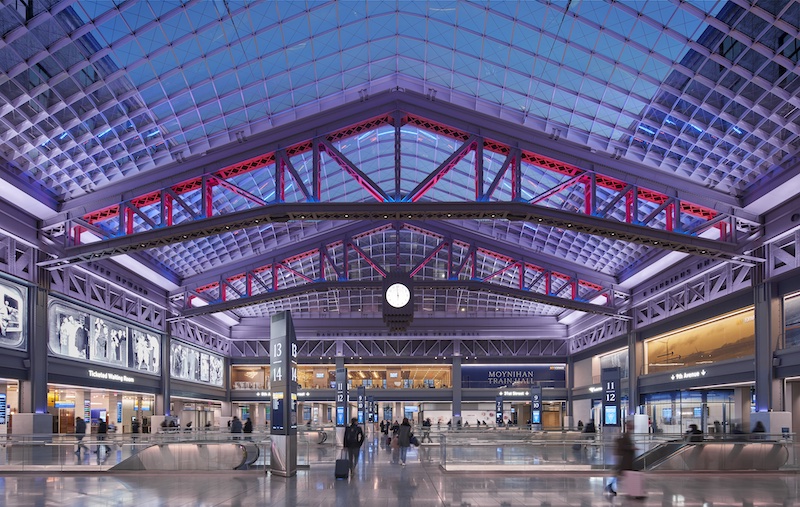

Moynihan Train Hall is the world’s first project to achieve a LEED BD+C for Transit certification with a silver rating for sustainable building practices. In addition to this accomplishment, Moynihan Train Hall has earned more than 50 awards, including the Grand Conceptor Award — the Top 2022 Engineering Achievement given by the American Council of Engineering Companies (ACEC), the Architecture Honor Award by the American Institute of Architecture’s 2022 New York Design Awards, the World Architecture Festival 2021 Award, Engineering News Record’s Award of Merit, the Municipal Art Society of New York’s 2022 MASterworks Best New Infrastructure Award, and more.
American Council of Engineering Companies (ACEC) President and CEO Linda Bauer Darr praised the project, saying “Sometimes, it is unnecessary to tear it all down to create something new. The Moynihan Train Hall project… breathed new life into a piece of New York City’s rich architectural history and designed a new gateway into the City that will awe and inspire well into the future.”


